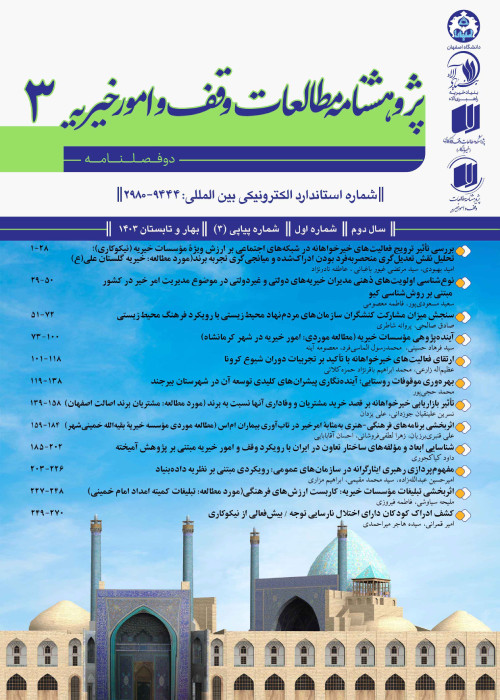Futures Studies of Charities and Philanthropy in Tehran
Many researchers have addressed the role of non-governmental organizations in Iran and have examined it from various aspects (Pirmoradian et al., 2019; Javid et al., 2017; Saliani and Vosoughi, 2016; Valimohammadi and Eskandarinezhad, 2022). The growing importance of these organizations in social life cannot be hidden. However, despite the numerous pieces of research that have been conducted on the nature, function, and history of these organizations in Iran, less attention has been paid to their future. Activists and policymakers in this field need to have information about possible and desirable future scenarios. Concerning the interdisciplinary field of futurology, to clarify the goals of this field, describe the current trends, explain the prevailing conditions and depict the possible and desirable futures, which are all the tasks of this interdisciplinary field (Bell, 2013), the present research tries to check the state of charities and benevolence in Tehran. The main question of the current research is the following: What will be the status of charities and philanthropy in the city of Tehran from the point of view of activists in this field in the future and what will be the desired situation? From this point of view, related domestic and foreign research have been reviewed and discussed (Shirvani and Rajabi, 2011; Majidi and Hamissi, 2013; Jalali et al., 2015; Saliani and Vosoughi, 2016; Razeghi and Lotfi-Khachaki, 2018; Parsons, 2002). It is worth noting that not much attention has been paid to the future research of charities and benevolence.
The current research is qualitative from the perspective of methodology and uses the qualitative Delphi method to collect, reduce and describe data. The main goal of the Delphi method is to predict possible alternative options for the future to influence the actions or thoughts of decision-makers (Bell, 2013). The main tool for data collection in the qualitative Delphi method is the in-depth and semi-in-depth interview, which is also used in this research. For this purpose, semi-in-depth interviews have been used to collect the data of the current research among senior employees and CEOs of charities in Tehran. The sample size of the present study was 12 people and the sampling method was theoretical. The participants in the research have been selected because they are all real or legal active members of the philanthropy environment of Iran. For this purpose, charitable activists who participate in active and prominent charities have been selected as examples of this research. In this study, inductive qualitative content analysis has been used. In this type of content analysis, researchers avoid using prior categories and instead arrange the categories to emerge from the data and float themselves on the waves of data to obtain new knowledge. Therefore, through induction, categories emerge from the data. From another point of view, the content analysis of the current research is of a conventional type, which means that the extracted codes are defined during the analysis of the findings, and the study is keyed by viewing the raw text instead of starting from the theory (Hsieh and Shannon, 2005).
Based on the qualitative content analysis of the conducted interviews, the extracted categories were categorized in the form of possible future and desired future. In the possible future section, two main categories of increasing organizational rationality and structural problems were extracted. Increasing the rationality of the organization, which is known for greater transparency and the use of new technologies, is one of the issues that researchers from other countries have also pointed out. Also, the meaning of structural problems is the pressure that is exerted on the actors of this field through external forces and limits them. In the form of the desired future, two categories of organizational development and solving structural problems were identified. Organizational development refers to the positive change of values, strategies, and techniques governing organizational work, which aims to strengthen individual skills and improve organizational performance. Solving structural problems refers to the removal of destructive external procedures that have made the activists of this field too bound.
It can be claimed that there is a significant difference between a possible and desirable future in the field of benevolence. The possible future will be associated with many structural problems as well as initiatives from benevolent organizations. Participants have acknowledged that despite the existence of multiple structural barriers in the legal, social, political, and economic domains, charities will transform themselves and change their fundraising and management practices. On the other hand, due to the type of society's interaction with charities, the financial and operational transparency of charities will also increase to increase public trust and attract more capital. The desired future in the structural field has an obvious conflict with the possible future. If we talk about the continuation of structural problems in the future in the discussion of the possible future, the desired future will include the disappearance of many of these structural problems as its usefulness depends on solving many of these problems. In the organizational field, however, the distance between the desired future and the possible future is not as great as in the former case. The desirable future that can be drawn for the charities of Tehran includes the stabilization of the independence of the organizations and the improvement of their position as structured organizations; what we witnessed to some extent in the possible future. Of course, it should be noted that these categories gain meaning in communication and interaction with each other. Therefore, if the structural problems disappear in the desirable future, the situation for the organizational development of charities will also be facilitated, and to some extent, the opposite proposition is also true
- حق عضویت دریافتی صرف حمایت از نشریات عضو و نگهداری، تکمیل و توسعه مگیران میشود.
- پرداخت حق اشتراک و دانلود مقالات اجازه بازنشر آن در سایر رسانههای چاپی و دیجیتال را به کاربر نمیدهد.


